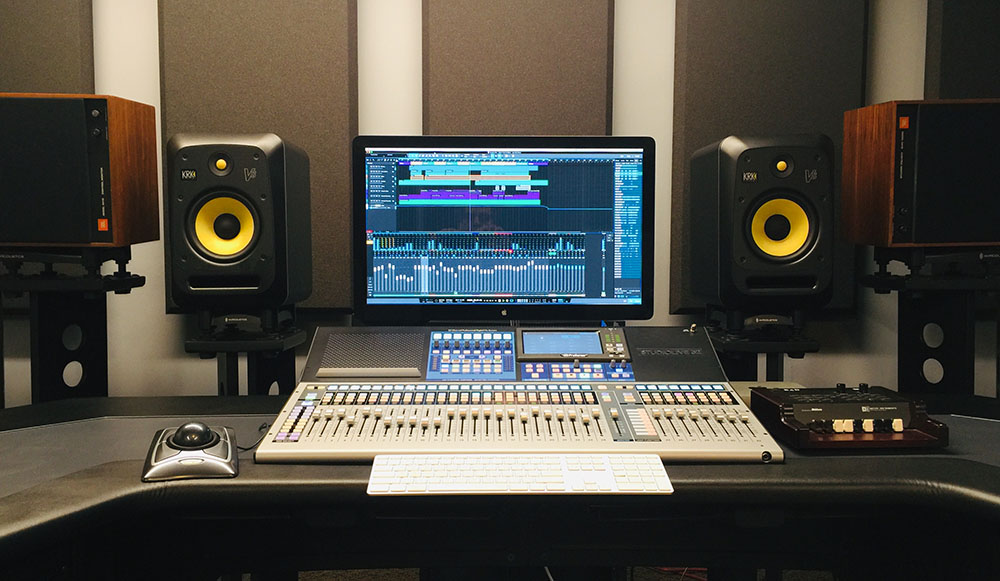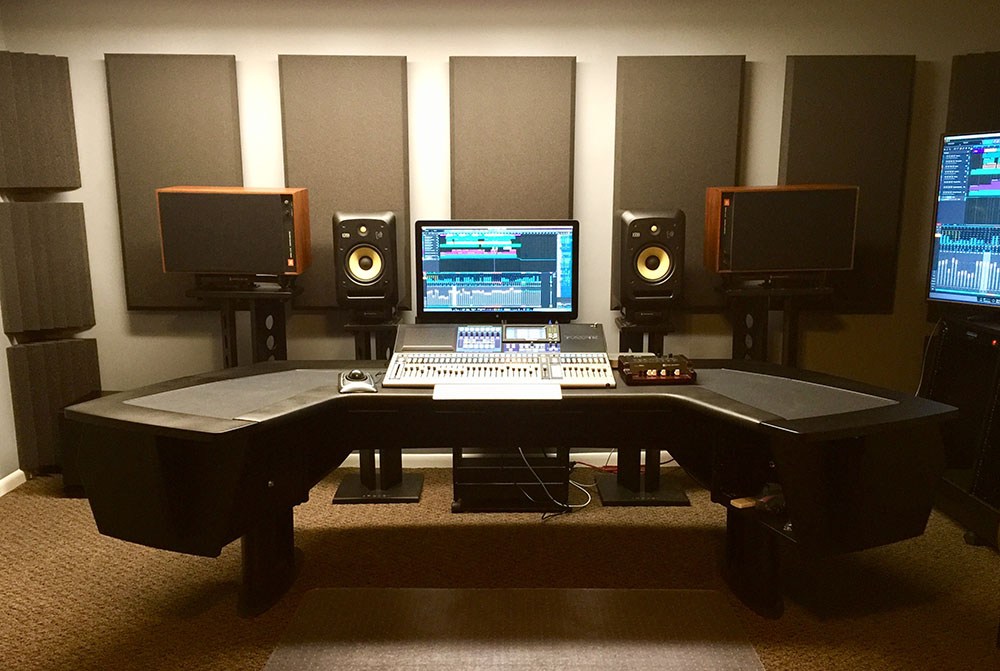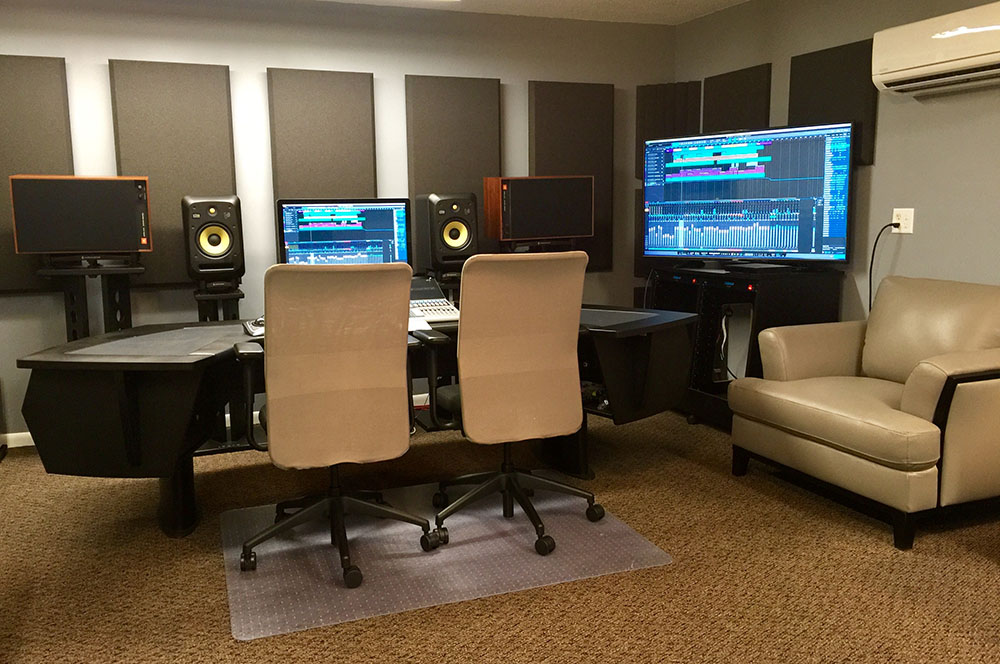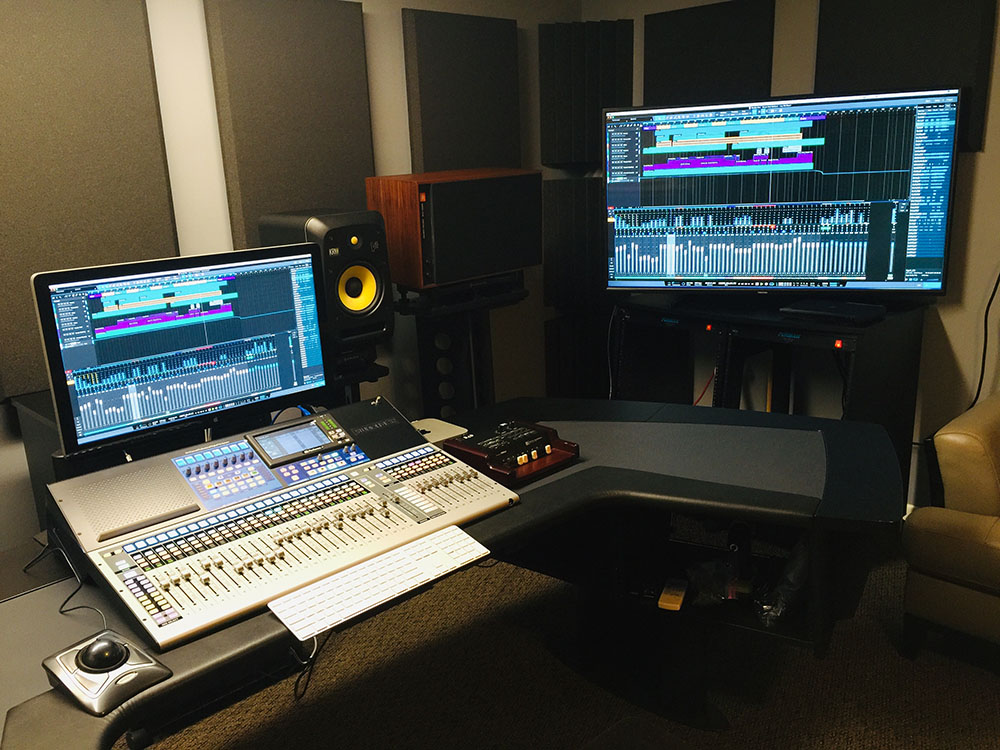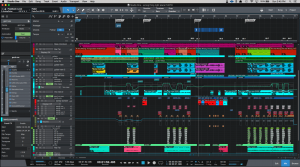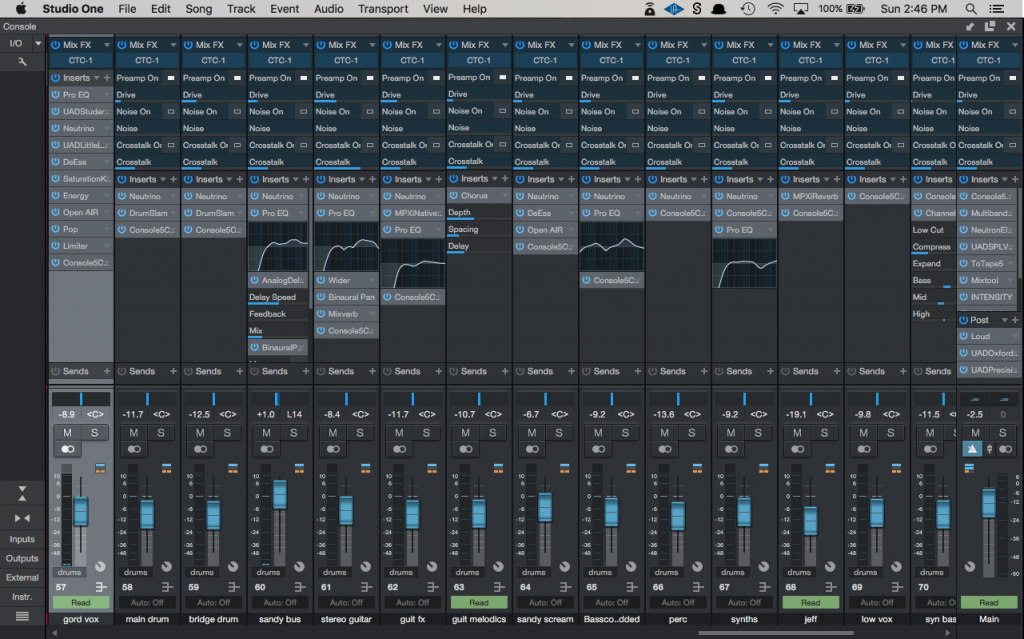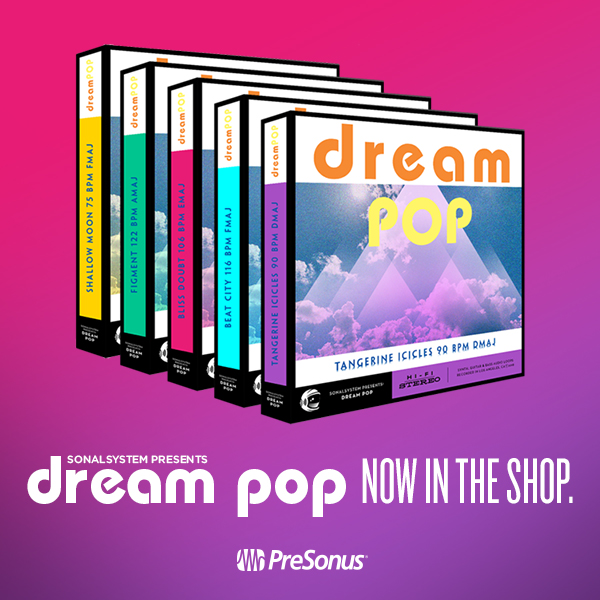Author Archives: Ryan Roullard
Justin Lassen on the Making of Black Fox Society: Abstract
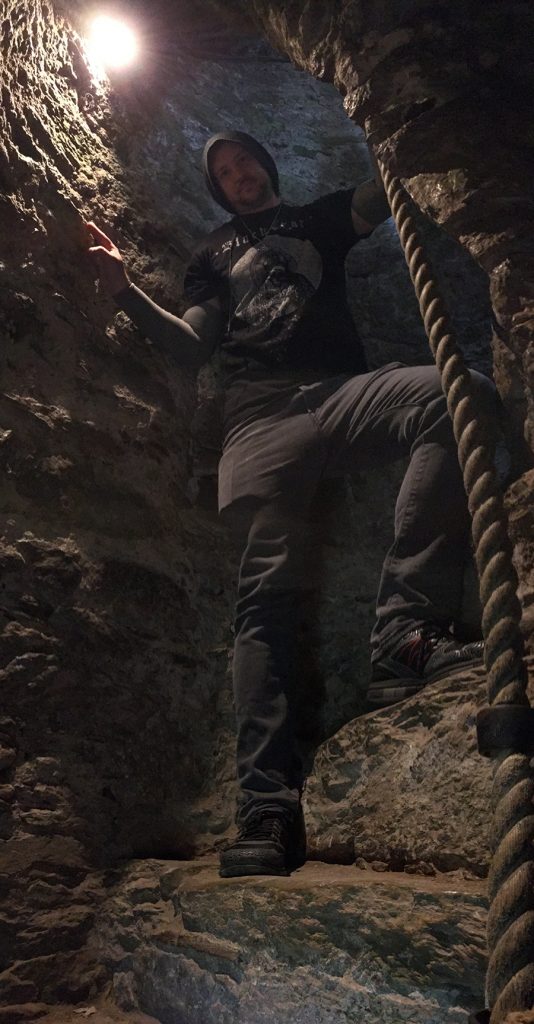
Justin Lassen is a composer, producer, sound designer, and good friend to PreSonus. Justin has had his hands in a LOT of music, TV, and video game projects over the years, but is perhaps best known for his best-selling sound library “White Rabbit Asylum.” Always one to outdo himself, Justin has followed it up with a spiritual successor called “Black Fox Society: Abstract,” available now at shop.presonus.com.
Let’s be clear from the get-go… this is not just another sound library. Justin spent ten years traveling to obscure corners of the earth to record strange and unheard sounds for this project, and then spent another year just editing them all together for this massive 3.7 gigabyte collection of loops, instrumentals, and industrial beats—all inspired by mysterious secret societies. He was kind enough to take the time to share some stories (and AMAZING photos!) of how this all came to be. Strap in, this one’s quite a ride.
Talk to us a little bit about some of the mysterious locations you went to—22+ countries is a LOT!
Secret societies have fascinated me for years. When I lived in Europe in my twenties, I became aware of so much history the world never hears about. Everything in these ancient cities is literally built on top of the previous generations. This means there are a lot of hidden spaces and forgotten stories to uncover. I knew that every country in the world has stories to tell, but I focused especially on the places that have shaped the world as we know it today.
I was drawn to places where I knew groups of influencers have gathered throughout time. So, I would start with plans to visit places that I knew would not only be visually intriguing but would also provide unique sound environments that could be crafted into high-quality ambient concepts. The most surprising part was what I would find along the way. As I talked to locals and explored some less-traveled roads, I found spaces that had a unique vibe, and I would stop and capture the environment before moving on.
Staying flexible in both my expectations of what I would actually capture, as well as where it would happen, allowed for some unexpected opportunities to capture some once-in-a-lifetime material.
For example, when I was in Korea, I received a tip from a local contact about a secret shamanic temple up in the mountains outside of the city. With very few people around, I was able to capture much of the mystical ambiance that was available among those sacred stones. Distant chanting and ceremonial bells enriched the environment more than I could have hoped.
In Europe, where so much history has been buried through the years, I made a point of going off the beaten path. This led me into ancient grottos, up decaying staircases, through ruins and forgotten graveyards full of nameless stones. You can’t be in these places without feeling something.
You might think that this is the magic behind Black Fox Society, but it’s these feelings that inspired me to take the recordings I collected around the world and shape them into individual works of art that evoke specific emotions, reminders of what I felt in these places.
What sort of field recording gear did you use?
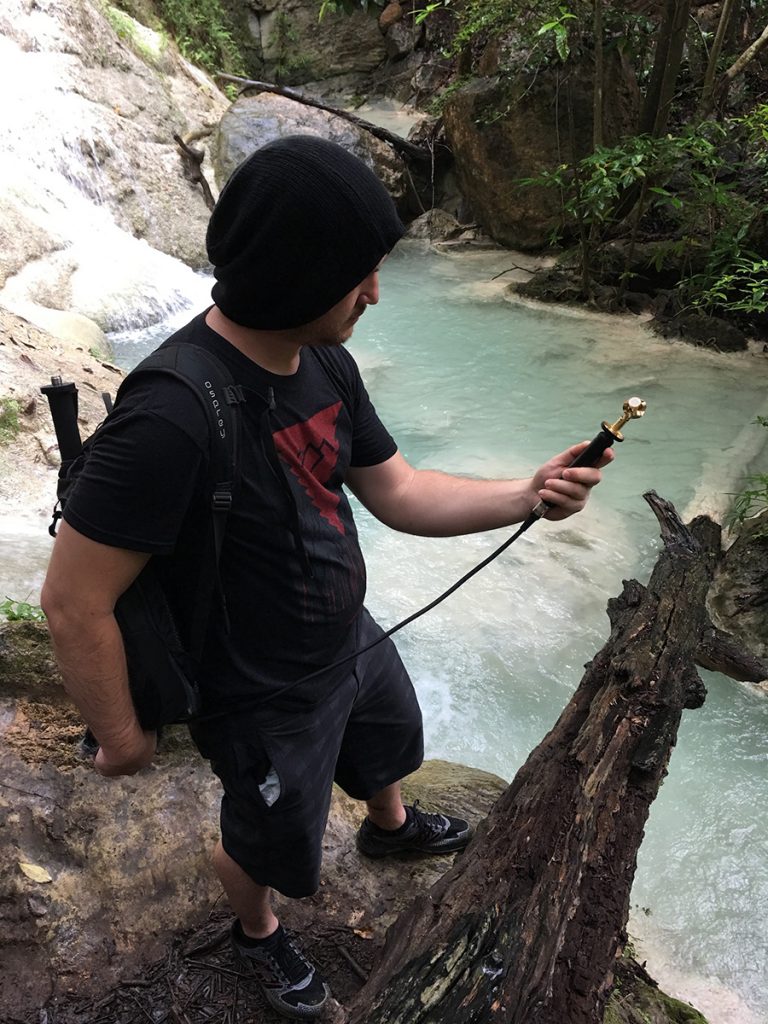
My primary field recording equipment was Zoom F4, Sennheiser Ambeo-VR Mic, and a Roland R-07 Recorder w/ Roland binaural headset/mic combo. I also brought a Netbook on my trip, several hard drives, and a ton of SD cards for the various recorders and camera equipment. I also used the Sennheiser Ambeo Smart Headset for some cool unique recording situations.
Any fave mics, recorders, etc? Binaural mics?
With all of that gear, and using all of it in each country and location, what ended up being my favorite piece of gear was the Ambeo Smart HeadSet, particularly when going into places that I wasn’t able to bring all of the mics, XLR cables, recorders. It ended up capturing some really beautiful audio that felt “3D” and even made me feel like I was “there” on playback. Upon returning from my trip, I actually got a ton of new equipment and microphones that I plan on bringing with me on my next set of adventures.
How do you keep such a huge collection of .WAV files organized when you’re busy traveling? One SD Card per location? Strict file naming conventions?
Keeping the files organized is easier than you might expect. I was walking an average of 10 miles per day in most cities. I was usually pretty tired by the end of the day! It was a non-negotiable routine when I would get back to my computer to download the work from that day. I would organize it by city and by date. I kept a concise log of my itinerary, including notes of where I went and what I did that day. I organized the video, pictures, and drone footage the same way and that helped keep everything straight.
The most important thing to know about the file management is that at the end of the day, the project didn’t demand location-specific end products. Creating the library was a much more artistic venture than just a single track pulled from a cathedral in Prague, for example. Each ambient loop in the library has 8 to 17 layers in them, each layer coming from different parts of the trip and world. The color of each audio sample was more important than the locale in deciding how it would be used in the final content.
The file names were simple, based on date and city. My criteria for what was worth including was determined beforehand, so I didn’t need to filter my content much when I got back. I ended up using almost every single thing I recorded!
Did you have any issues getting all of that recording gear and media from country-to-country (through international customs) in your travels?
Yes, actually. I was at airports almost every other day, and no airport ever took it easy on me. I had to take everything out of its case, out of the bag each time, to show them that it wasn’t some elaborate mechanism. I even had to throw away batteries and things in some countries. I think the next time I do a trip like this I want to simplify the gear even more. What a lesson to learn. What is very good news is that recording equipment is getting smaller and smaller, even for ultra-high-definition audio. Taking the drone out of its case was also not fun at all. The 4K camera and gimbal system also looked strange on scanners, so that had to come out of the bag as well. I almost missed a few flights because of some of the security screenings taking longer than they should have. I’ll pack lighter next time… and I thought I was pretty light to begin with!
What were some challenging moments in the field and why?

Some of the most challenging moments for me was the physicality of this kind of immense travel. Walking 10 miles a day on foot, meant I needed shoes that would keep me alive and moving forward. A lot of people saw my Instagram during the travels and thought it looked like a fun trip and gorgeous photos and stories. Parts of it were fun, but most of it was insanely long hours and hard work. Not just the recording aspect, but moving from place to place, getting equipment out at the drop of a hat if we happened to venture upon something unplanned but totally interesting and worth capturing. A lot of this trip was filled with those surprise moments.
Other challenges included making sure we didn’t get lazy with organizing the content. At the end of each night, no matter how tired, I had to make sure to file things away, organize things on the hard drives (multiple hard drives for backup) from all the SD cards and recording equipment.
I got sick during parts of the trip, but still had to keep moving forward. I had a goal and a dream, and a lot of tickets booked. I couldn’t miss flights or trains or cars, even if I was sick, I had to venture forward and keep on schedule and on track. In a lot of ways, it’s like a band on tour. Band tours are hard and grueling work. You’re expected to perform in each city, and there is no “fun time,” as each day in between is only used to travel to the next set of destinations. I didn’t get to stop and rest very often at all if ever. Carrying an entire studio on my back, gear and everything as we walked was also hard work. My feet were sore, but I knew I had to get through all of these countries and try to find the best audio I could find. I made sure to do a lot of research in between travel to pick interesting places that fit the sounds and environments I was going after.
Did you discover any amazing new foods/dishes that were firsts?
We always ate the best food in each country in general, but one of my absolute favorite places to eat was Thailand! That country has some awesome food. In particular, I had the honor of feasting on the award-winning menu of Chef Bee Satongun (who was awarded Best Female Chef in Asia, 2018.) So pretty amazing and humbling to be eating dishes from one of the best of the best in all of Asia! Her food has so many flavors and textures that create little worlds of their own! She was an artist. She even let me bring recording equipment into her kitchen to capture foley design, sound design and ambiance while she was cooking and creating her masterpieces. We recorded all kinds of ambisonic stuff even with food! ?
How did the people and the countries’ overall vibe and energy affect your project sonically?

People always affect my creative process wherever I am in the world. Sonically, each group of humans spoke different languages, so that created a new ambiance wherever we went. Humans have different tonal qualities depending on the language they speak. If you add large groups of them together, you get very different textures in general. For crowds, trains, or cityscapes, it is the people, the human beings, with voices that bring those places to life. Night markets in Korea vs. day markets in Thailand or heavily touristed areas in Europe all had their own tones and chatter. Even different train tunnels and docks of people sounded different from place to place.
Each country also had its own general vibe and energy. Of all the places I went, I think I really loved Ireland the most. The people there were so warm, friendly and caring. Not to say that there aren’t warm and friendly people in other places, but for me, I felt right at home in Ireland. Driving through the countryside (on the wrong side of the road, haha) was beautiful to experience. It’s these kinds of vibes and energies that differ in all these places. The jungles in Thailand or even getting to play with an elephant in a river was one of my most memorable experiences. Yes, we recorded audio from my playtime with the elephant, but being near this beautiful creature had a pure energy around it that I will remember until the day I die. I got to do so many things and meet so many people that it will be years of stories that I can recall for years to come!
OK, let’s not forget that getting there is only HALF the fun. You spent a year editing this stuff together, so here’s some post-production questions:
Any particular tricks or processing that came in particularly handy?
I love the “markers” in Studio One, especially when “exporting”, it makes cataloging and batch exporting so much easier for one-shots and custom sound design layers. I didn’t want to just make a generic “found sound” kind of library, so I did a lot of editing, manipulation and huge chains of plugins to process and change the audio for some of the layers. I wanted to maintain the realism of the raw samples and augment them with stories and sonic ideas. However, I still wanted to maintain the vibe of the places I visited. I collected my own impulse responses (IR) when I could in certain places, and then used those to further edit location audio in other places, to create an amalgamation of different textures and moods. Like taking the reverb IR from a cathedral in one country and using it to process the outdoor space of a jungle or a cave and so on. There were no “rules.” I didn’t want to give myself any barriers. I wasn’t making a “documentary” about world travel. I was telling a story about secret places and societies. I was using the sounds I found all over the world simply as colors, that I could dip into and paint new landscapes and seemingly otherworldly places to explore. My body explored these places on the trip, but my mind further explored these places back home in the studio on a deeper level.
I love being able to collect the spirit of a place or situation and go for hyper-realism in some situations and majestic imagination in others. That is my favorite thing about sound design and audio editing. Every sample, every foley design, every hit, every texture, every ambient space can be broken apart and put back together in a million different ways like lego bricks. Although I have a pretty generously-sized library that I released, the trip still has over five terabytes of raw audio collected as a well of inspiration for future dreams and future projects to come. It was an amazing journey. I felt like Indiana Jones in some places.
You mention that Black Fox Society is ideal for use in VR and games. What are some of the considerations made in the tracking phase as opposed to recording sounds for traditional stereo use? 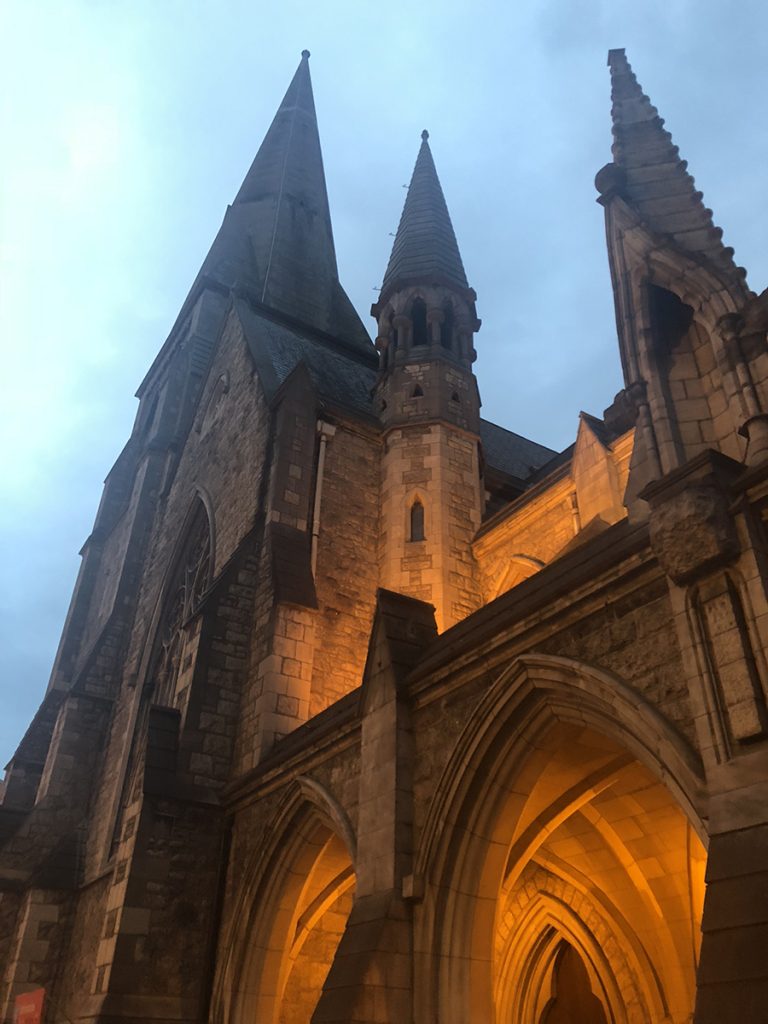
I work in Unreal and Unity engines a lot on the games that I get to work on, so I’ve had years of experience in implementing audio assets into interactive programs, attractions, rides, video games and virtual reality experiences, including the 2018 Emmy-nominated Spider-Man VR Experience which I was Audio Director for. I have been getting more heavily involved with surround audio in the last half decade, more-so than any time in my career—although I started doing surround remixing and composing with DTS back in 2004! For Black Fox Society to be useful for me as a sound designer for these kinds of experiences, I wanted to make sure that the audio felt “spatial” and like I’m “there.”The more spatial, the more useful for me and other sound designers in these fields.
I made sure to collect a lot of 3D audio/binaural audio, particularly because it can translate well for video games, VR, trailers, and movies alike. Ambisonic audio is great because you can collapse it down to a binaural field with very straightforward plugins. I relied heavily on environmental captures, impulse responses, and natural spatial audio in the places I traveled. I made sure to sit still and collect several minutes of each place I visited and cut out the most useful parts and augment with other audio captures to create little audio paintings. I didn’t want a “generic” library with no soul, so I made sure to mix and match different environments together to create the illusion of new places and new worlds (and new stories, as you can tell from the titles that evoke interesting emotions!) That was my favorite part of all of this sound design. I wanted to make a plethora of useful ambient audio that could be used in a number of different scenarios and still feel fresh to each new sound designer working on their own projects.
How did this library differ for you in terms of the workflow process, compared to say… White Rabbit Asylum?
White Rabbit Asylum was a more drawn-out casual creation process. It was collected over a decade from any kind of recorder I had on me at the time. From really bad microphones to really good ones and everything in between (cell phones, tape recorders, (yes, tape!) cameras, early generation portable recorders, etc.) White Rabbit Asylum did not have binaural audio or surround audio. It was merely a collection of interesting audio from my travels and adventures around the world at that time in my life. It was like a photograph or snapshot of where I was in that time of my life. White Rabbit Asylum was never meant to be a “library,” it sort of just happened naturally and organically over time from an enormous amount of collected and recorded audio. I was approached by Sony to release it as a “library,” so I edited and composed some interesting loops and story ideas with all that audio and created a haunted, surreal, otherworldly vibe with that collection. I wanted to make a library that I would want to use as well. I’m very proud of it to this day as a piece of my history.

Black Fox Society is a more deliberate approach. I traveled the world knowing I would eventually create a new library from the content I collected and recorded. It’s a spiritual successor for sure. Almost five years ago my friend Jim and I met in Louisiana and found that he was a fan and user of my previous library. He and many others have asked me over the years “When are you going to create another library?” I never quite had an answer for that because I was always busy working on so many different kinds of projects. I was doing a lot of pioneering surround work, 3D audio, binaural and ambisonic audio for Virtual Reality immersive experiential attractions and projects in these new industries. I was going out and collecting new audio for each new project, one at a time. Designing stuff from the ground up from scratch. Very tedious.
There aren’t a lot of libraries on the market with ready-to-go loopable immersive audio, so I wanted to put in a lot of hard work and heart and soul into this library so that not only would I want to use it but it might inspire others to use it for their own dreams and visions too. I wanted to create a library that could help not only me, but other VR producers and sound designers, attraction designers, film and video game editors fall into these beautiful sonic worlds. I hope that this inspires a bunch of new experiences and immersive stories for years to come. I especially love how all the layers work together in different ways for different moods and feelings.
More from Justin:
- Buy Black Fox Society: Abstract
- Sampling Surround Sound and Binaural Audio for Use in Virtual Environments and Games (via Intel)
- SoundCloud
PreSonus Symphonic Orchestra has been updated
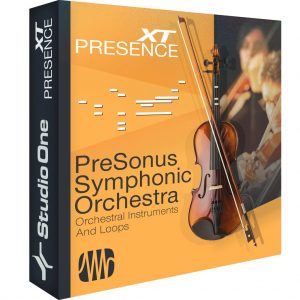
- key switch assignment in “Orchestral FX KS”, “Orchestral Tuba”, “Tenor Trombone”, “Japanese Bowles”, “Temple Blocks”
- sample mapping in “Harp FX”, “Strings FX”, “Trumpet FX”, “Celli FX”, “Brass FX”, “Flute FX”, “Orchestral FX KS”,
- round robin volume inconsistencies in “Viola – Staccato”
- loop points to “Viola – Arpeggios” (major, minor, diminished)
- layer and release sample volume in “Viola Section”: Staccato, Tremolo, Trill HS, WS
- wrong key switch removed in “Viola Section”: Trill WS
- loop activated in “Viola Section”: Arpeggio minor/major
- layer gain in “Big String Section – Staccato”
- sample start points in “Bass Section – Pizzicato”, “Bass Section KS”
- Uninstall PSO Contemporary Strings.soundset and PSO Classic Orchestra.soundset via the Studio One Browser:
- Go to the browser file tab
- Open the Sound Sets folder in the root
- Locate the Sound Sets mentioned above
- Right-click on the Sound Sets and select “Uninstall”
- Install the new versions:
- In the application menu, select “Studio One Installation…”
- In “My Purchased Items” select the two new Sound Sets of the same name
- Click “Install”
Via web browser:
- Go to my.presonus.com and log into your MyPresonus account
- Go to My Products > Add-Ons
- Locate PreSonus Symphonic Orchestra and click “View more details”
- Download the two new Sound Sets (PSO Contemporary Strings and PSO Classic Orchestra)
- When download is complete, drag the new Sound Sets into the Studio One application window while running
Glenn Rosenstein on the FaderPort 16 and and the StudioLive Ecosystem
This just in from Glenn Rosenstein, a three-time Grammy-winning mix engineer whose credits include U2, Madonna, Talking Heads, The Ramones, James Brown, Miles Davis and many others. His work in film and television has landed him both an Oscar and a Golden Globe while working on projects including The Sopranos, Celebrity Circus, The Last Emperor, Blown Away, Married To The Mob, Charmed, Beverly Hills 90210, All My Children and Buffy The Vampire Slayer. We recently got in touch with him to get his perspective on all things PreSonus.
Hey Glenn. Tell us about yourself!
I’ve had a fun career that’s led me to many musical adventures. I started early on at Power Station in NYC, then as a staff engineer at Sigma Sound Studio. I became an independent mixer, then producer, eventually winning some Grammys and selling a bunch of records, back when that was a possibility. I’m still producing both for my Sony labels, as well as independently. I partner in a number of project studios in Nashville, Muscle Shoals, and New York, as well as having a room at historic Fame Studios.
What PreSonus products have you used and which do you currently use?
I’ve always been a PreSonus user. As time goes on, PreSonus continues to release products that almost anticipate my needs. I started out with the ADL 600, a very tasty stereo mic pre from a few years back. I’ve put together a pretty cool room in my Muscle Shoals facility that’s centered around the StudioLive 64S, along with some great AVB powered PreSonus peripherals: The StudioLive 32R, the EarMix 16M, and the SW5E among them. Also to be found are the PreSonus R80 monitors and, of course, Studio One. And I always travel with my Faderport 16. Always.
For what applications are you using the products?
My PreSonus facility is very much a writing/production room that is easily convertible to a full-blown production studio. I like the creative ease and intuitive design that is integrated into all of the PreSonus cosmos of products. It’s simple to start off small—just creating some beats or a few phrases on guitar or a vocal idea—and easily push that to a bigger, more robust production without having to shift rigs.
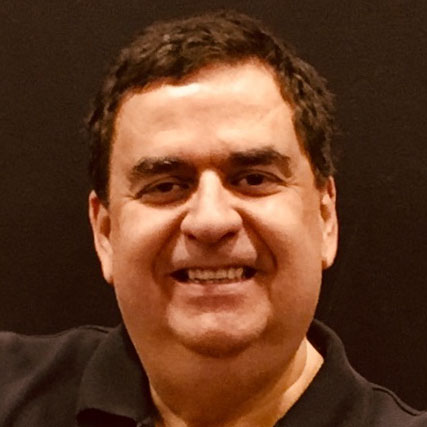
What led you to choose these particular PreSonus products?
I had a pretty solid awareness of the PreSonus offerings for many years and was fortunate enough to meet and spend some time with Jim Odom. His backstory is steeped in music production and performance, and, ultimately, creating solutions that he wanted for himself. I liked that a lot. I still do. I totally get the narrative of PreSonus products, their evolution over the past few years, and their remarkable value. Jim and his team are always pushing the boundaries—they’re taking insane amounts of features and options and putting them in boxes that should cost five times what they’re asking. I have no idea how they get it done, but they do. And all that filters down into very usable tools that sound great and are fun to work with.
Having used the gear, what do you like most about the specific PreSonus products you use?
Let’s talk about the Faderport 16: A 16-channel control surface that fits under your arm—brilliant design and execution. Regardless of my preferred DAW, I always feel right at home. I’m in a hotel, it’s there. I’m in a rehearsal room, it’s there. Perfect combination of small footprint and functionality.
Mixing Competition with Recording Revolution, Splice, and Briana Tyson
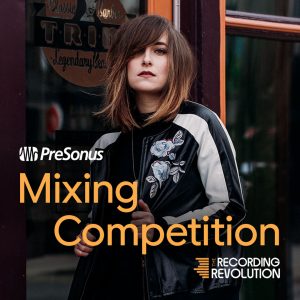 We’ve partnered with Splice, The Recording Revolution, and Briana Tyson for a mixing competition!
We’ve partnered with Splice, The Recording Revolution, and Briana Tyson for a mixing competition!
Practice your chops bringing stems from Briana to life and share your best mixing tips and tricks with the rest of the community! Here’s how it works. Click the link below to visit Splice and download the project files and stems for Once all the mixes are in, Graham from Recording Revolution will listen through the mixes and choose the one he thinks is radio ready to win his premiere mixing course Mixing University, a pair of Eris E66 Monitors and a copy of Studio One 4 Professional, an Eyeball microphone cover from Kaotica, a video call with Briana Tyson, and consideration from Briana Tyson for official release!
Click here to learn more and sign up!
Spoons’ Jeff Carter and Sandy Horne on PreSonus Studio One
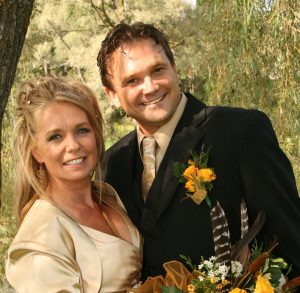
Sandy and Jeff
Spoons are a long-haul Canadian new wave band formed 1979 in Burlington. Jeff Carter is their longtime producer, collaborator, and husband to founding member/bassist Sandy Horne. Jeff got into Studio One after years in analog recording, including some time with PreSonus’ FireStudio interfaces when collaborating with Sandy and helping her set up her studio.
When Studio One version 1 was released, they switched from Cubase… and were able to collaborate so effortlessly together that Jeff actually credits Studio One with helping cement a relationship with Sandy—which culminated in their marriage!
On the other hand, Sandy calls this scenario the “Hire-a-Husband” program, so the truth is probably somewhere in the middle. But they’re married and happily making beautiful music together to this day. Jeff has a lot of nice things to say about why he chose Studio One and how he uses it:
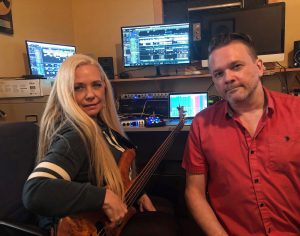
Sandy and Jeff in the Studio
What PreSonus products have you used and which do you currently use?
I’ve used all kinds of PreSonus hardware, going back to the early FireStudios, then the Firestudio Project, and then the Firestudio Tube, which I still use on our older iMac system—the new system is using a Thunderbolt interface. Static in Transmission was recorded entirely with those various FireStudio interfaces, with the help of a Presonus HP4 headphone amp. We also use a new PreSonus Studio 26 as an interface for live shows, for the keyboard player’s virtual instrument outputs and backing tracks. I’ve also had the opportunity to mix live on various versions of the StudioLive consoles, going back to the first generation, which has been a joy, as they’ve all had an intuitive layout, similar in philosophy to Studio One. I’m now using a Faderport Version 2 in the studio as well, which has been great for streamlining certain functions, like scrolling the timeline, mutes and solos, transports, and writing automation.
But overall, Studio One Professional has been far and away the most important addition to Sky Studios, and since its inception, we’ve used every subsequent version of it since the beginning. I have other DAWs… pretty much all of the major ones; I keep them around, mostly just in case clients bring files in from other systems for me to mix; but even then, I’ll bounce the stems over to Studio One, or just export the files as OMF—which is another fantastic addition to Studio One that’s made my life so much easier!
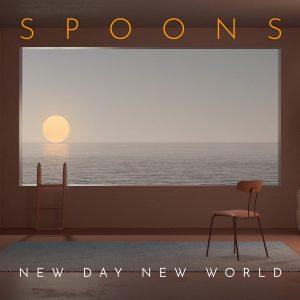
Spoons’ Latest Album
For what applications are you using Studio One Professional?
I use Studio One for almost anything audio and/or MIDI related: composing, recording, mixing, re-mixing, post-production, sound design, and mastering. Now, with Studio One, the big eye-opening moment for me happened with version 3, when the Console Shaper was first added. Finally, my mixes started to have some of that subtly-more dynamic, organic, and harmonically “gelled-together” sound that I had been chasing ever since my days mixing on that big ol’ Trident console back in the 90s. When CTC-1 (on sale now!) came out soon after, I immediately bought it, and it’s made a stunning difference. On New Day New World, I tended to use the Tube Mode on bass and certain synth busses, because there’s a low-end warmth that it imparts that I really dig, and the Classic Mode was sometimes used on guitar or vocal busses—but the big winner was the Custom Mode, which was used on many things, but always used on drums, and on the 2 buss, boosting the “drive” and “character” parameters just enough to get the tracks into that sweet spot where things sound full, yet detailed, and open, yet tight. For all those who have Studio One Pro 3 or above, try it: you’ll know what I’m talking about as soon as you hear it.
What led you to choose Studio One? Was it the company’s reputation, audio quality, ease of use, specific features, price, other factors?
PreSonus has always had a solid reputation, but it was being shown real-world examples of how intuitive it is to work with that really sold me. With Long and McQuade, I almost always physically demonstrate Studio One, as opposed to just talking about it; the workflow sells itself. The audio quality of the 64-bit mix engine, especially with CTC-1 in use, is like nothing I’ve ever worked with, excluding large analog consoles. The Presonus Symphonic Orchestra Add-on is also great sounding, from the subtle, switchable articulation in the string sections, to the warm brass, to the orchestral timpani and percussion. You can hear it all over the opening track of New Day New World, and on the strings at the end of “Love Recall.” The pricing for Studio one is more than reasonable considering what you get; and the Artist version being included with even the least expensive PreSonus interfaces is honestly a total steal.
What Studio One features have proven particularly useful and why?
The automation mapping is so simple that it encourages me to get more creative, easily automating subtle things like synth detuning, delay mixes, and feedback, or rotary speaker speeds. I’m no longer afraid to try things like that while working with an artist in the studio with me, as it doesn’t really slow down the pace of work, or hamper the creative process, because it can be done so quickly. On previous DAWs, If it was too time-consuming or tedious, I might have to try things like that on my own time, or possibly not at all. There’s a part in the dub/soca-influenced bridge of “All the Wrong Things (In the Right Places),” off New Day New World, where the guitar track pans wildly back and forth, but still in rhythm with the song, while you can hear the Analog Delay plug-in (the long echo on Gord’s vocal) subtly deepening its modulation depth (which detunes the vocal only in the feedback loop), which were all relatively easy to do with the preset automation shapes coupled with the transform function.
Being able to cross-fade overlapping audio clips with just the press of the “x” key, and adjusting the slip points and volume offsets of clips with such easily variable curves is dynamite… something I use all the time. The VCA implementation is logical, and being able to easily write VCA automation to tracks is a real-time saver as well.
The new chord track has come in very handy too; in “Repeatable,” there’s a guitar solo that comes in around the one minute mark that I thought was too similar to the one near the end of the song, so I extracted the chords from another (rhythm) guitar track, then transposed that first solo up 5 or 6 semitones (which obviously put it out of key), but then set it to follow the rhythm guitar’s chord track, which not only put the solo back in key, but it made sure the lead part still followed the song’s changes, creating this new solo part that had the same feel as the later solo, but with a new, higher-pitched variation on the notes, making it quite distinct.
How does Studio One compare to other DAWs you have used? What does it give you that other DAWs don’t?
Like I’ve mentioned, workflow is one of the biggest reasons to use Studio One; automation assignments of almost anything that moves on-screen are only a right-click away (or a simple drag-to-track from the little hand in the top right) Clip gain offsets, slip edits, and fade-in/fade-out/crossfade edits are super easy and fast. Time-stretching clips to bar and beat lines is a similarly-simple Alt+drag. In Studio One, I use custom keyboard shortcuts for changing the note values in the drum editor; that way I can switch between painting in 8th note/16th note/and 32nd note hi-hat rolls, for example, on the fly. In most DAWs, that’s not something that’s easy to set up, if possible at all.
The new Tempo editor, with its easy to draw in curves, is a vast improvement over the previous version; I used those curves to give a subtly-increasing energy-boost to the choruses of “All the Wrong Things”.
The MIDI editing is, and has always been great, and it’s not cluttered, and the automatic assignment of sample-pad names (Kick 1, Snare 2, etc.) to lanes in the drum editor is a huge time-saver, and about as easy as I could imagine it being. But I’d really like to see 1/8D and 16D (duplet) showing up by default in the quantize options, along with ⅓ and ⅔ (33.3% and 66.6%) swing values. Would be handy for the jazz and hip-hop crowds as well. Along those lines, I use the X-Trem effect a lot, like on the rhythmic guitar stutter in “Life on Demand,” and the quick, sliced-up synth in the chorus of “Snowglobes.”
Being able to extract MIDI note data from audio recordings (via the Melodyne Editor) is something I never imagined possible, and it’s so simple to do: just drag the “Melodyned” audio clip to an instrument track! I used that trick to create a sub-octave synth bass (triggering the Mai Tai analog synth plugin) that follows along with Sandy’s live electric bass all the way through “All the Wrong Things,” and in certain parts of several other tracks.
Which Studio One feature or concept doesn’t get enough spotlight (or isn’t talked about enough) in your opinion?
CTC-1 and Mix Engine effects doesn’t get near enough praise! Especially the “custom” model. Absolute magic. There’s a screen-shot here of the mixer, with lots of instances of CTC-1 open on all the busses. I’d like to try out the Softube tape shortly as well, as it looks very promising.
Mai Tai is also a fantastic-sounding yet still perhaps under-praised synth; I used it all over this record, not only for pads and sub-bass, but critically, the main, echoed synth-patch which sets the overall tone and vibe of “Landing Lights” is a Mai Tai patch (Poly-Arp3), that I modified to be a bit tighter and pluckier.
Any useful tips/tricks or interesting stories based on your experience with Studio One that would be of interest to our user base?
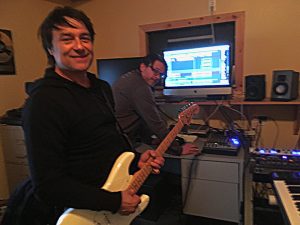
Jeff and Gord of Spoons in the Studio
With Mai Tai, you can get some FM-ish (frequency modulation synthesis) tones out of it, by modulating the rate of LFO 1 (set to max speed) with the rate of LFO2 (also set fairly high, which sends LFO 1 into audio rates) and then assigning LFO1 to oscillator pitch. Then, modulating the rate or amount of LFO2 can give you some cool, edgy/grindy synth FX patches, that are somewhat controllable, but still musical. I used that trick to create the wild “CPU-freaking out” synth-madness you hear on “Perfect Exception”. Of course, I’d LOVE to see a simple, dedicated FM synth added at some point (or even straight-up FM added to Mai Tai!)
Another thing I discovered was a variation on Craig Anderton’s “Tonal Verb” concept, that he wrote about a while ago on the Presonus blog.
But instead of using two nearly identical reverbs on an FX buss, I use the same technique to create two nearly-identical, but out of phase compressors, inserted directly, just changing the attack or release on one or the other; all you end up hearing is the difference between the attack (or release) portions, and I’ve used this to get rid of excessive decay or resonance in snare and shaker parts, setting one compressor’s attack to “0”, and opening the other one up a bit, leaving only the transients. Use longer attacks on both comps to create “soft” guitar or drum parts, where the pick attacks and stick hits swell in.
Similar concept can be used with two near-identical but out-of-phase EQs, where one EQ has peak or valley points and the other doesn’t; all you hear is what’s “inside” those difference-peaks, and nothing else…sort like a multi-band bandpass filter. Great for capturing only the “ring” or resonance points of an interesting, but otherwise-messy snare sample, which can be blended in with other, cleaner snares. ( I used this on one of the drum layers in “Repeatable”, where the original loop was recorded from a drum loop in a vox amplug practice device, that had a neat character that I only wanted to capture certain parts of) The groove extraction feature came in very handy there as well, as I was able easily match up the feel of that sampled drum loop with my added Impact drum samples.
Any final comments about PreSonus and Studio One?
This is the second interview with me that PreSonus has been so kind to do; the first one came out almost eight years ago after Static in Transmission was released. I have to say that PreSonus, as a company, has not only had great support for me and thousands of other customers, but you’ve seemed to go out of your way to encourage and inspire musicians of all kinds. In the past eight years, I’ve grown more and more comfortable with Studio One, but despite that level of comfort, I’m still discovering new things I can do with it every week, partly thanks to the great articles and learning videos you post on your blog. It’s been an incredibly satisfying and exciting experience growing along with your software and your company, and I look forward to it remaining an integral part of my musical life. Thanks for making great software!
Jeff Carter and Sandy Horne—Spoons.
Keep up with Spoons:
- Website
- Sandy Horne Project
- Shroud (Jeff’s Sci-fi / Fantasy animation project!)
Introducing the StudioLive Flex DSP Update!
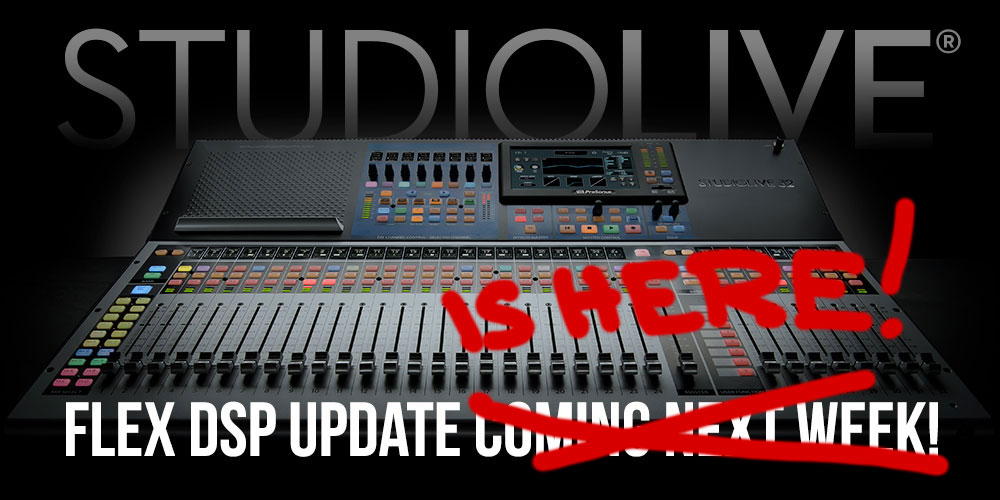
[UPDATED 3-28-19: The FLEX DSP Update is LIVE! GET IT!]
Big news for StudioLive Series III mixer owners—get ready for some dramatic improvements to your mixer in the new StudioLive FLEX DSP update!
This update,w̶h̶i̶c̶h̶ ̶w̶i̶l̶l̶ ̶b̶e̶ ̶r̶e̶l̶e̶a̶s̶e̶d̶ ̶n̶e̶x̶t̶ ̶w̶e̶e̶k̶, which you can get RIGHT NOW, consists of:
- Universal Control 3.0
- UC Surface 3.0
- StudioLive Series III Firmware 2.0
- Capture 3.0
- QMix-UC 3.0
- Studio One 4.1.4
Once you’ve installed the above, here’s what you’ll get:
New in StudioLive Series III Firmware 2.0:
- You’ll be able to place Fat Channel compressor and EQ plug-ins on every output bus simultaneously (this is in addition to every input channel supported in previous firmware)
- Scenes will be updated to improved Project/Scene workflow
- Ten highly customizable User Profiles with deep custom permissions settings
- Fader response now 50% faster
- Screen updates more than 70% faster
- Screen touch response 90% faster
- Scene loading up to 75% faster
- Increased USB and AVB channel counts: 128 (64×64) via each USB and AVB
Note that this update WILL restructure your existing scenes—be sure to back them up before installing the update! Click here for instructions on how to do that.
New in Capture 3.0:
- Export a Capture session from your computer for SD Card playback on a Series III console mixer
- Import and export AAF files for compatibility with other DAWS
- New metering options including Peak/RMS meter, adjustable RMS and VU-Hold time to better fit multiple various use cases
- Channel color syncs with Series III mixers
- Updated user interface with light and dark modes for better viewing in different environments
New in Studio One 4.1.4:
- This is a simple maintenance update to add compatibility with the above mixer features
New in UC Surface 3.0:
- Added support for all the amazing new features listed above!
Click here for Firmware update instructions.
Questions? Check out this series of videos from Ray on all the new stuff.
StudioLive Flex DSP Update—Auf deutsch
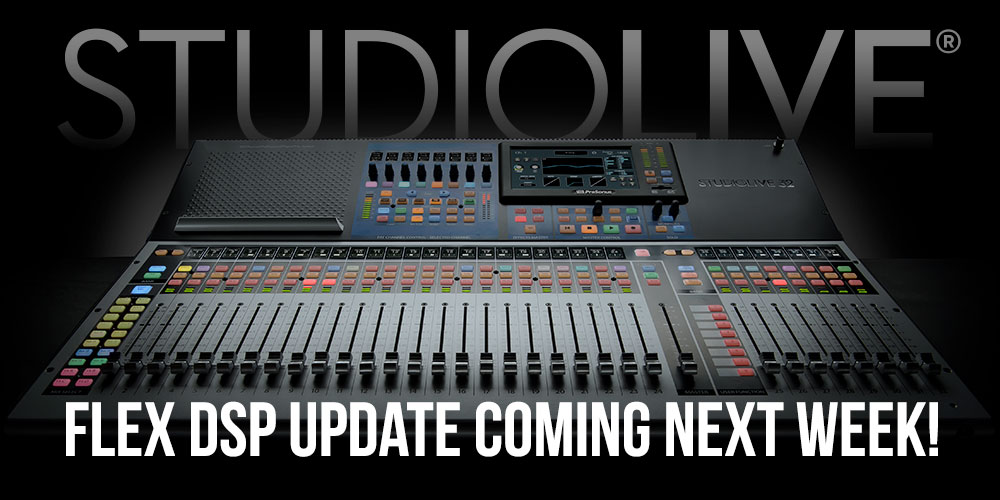
Großartige Neuigkeiten für alle Besitzer von StudioLive Series III Mixern – macht euch auf einige dramatische Verbesserungen im neuen StudioLive FLEX DSP Update gefasst!
Dieses Update, welches wir in ca. einer Woche veröffentlichen werden, enthält:
- Universal Control 3.0
- UC Surface 3.0
- StudioLive Series III Firmware 2.0
- Capture 3.0
- QMix-UC 3.0
- Studio One 4.1.4
Sobald diese Updates installiert sind, erhaltet ihr folgendes:
Neu in StudioLive Series III Firmware 2.0:
- Es wird möglich sein, Fat Channel Kompressor- und EQ-Plugins auf jedem Output-Bus gleichzeitig einzusetzen (zusätzlich zu jedem Input-Channel, was bereits durch die vorherige Firmware möglich war)
- Szenen werden zugunsten eines verbesserten Projekt- / Szene-Workflows aktualisiert.
- Zehn hochgradig anpassbare User-Profile mit tiefgreifenden, individuell abgestimmten Zugriffsrechten
- Fader reagieren jetzt 50% schneller
- Szenen aktualisieren mehr als 70% schneller
- Reaktionszeit des Touch-Screens um 90% verbessert
- Szenen laden bis zu 75% schneller
- Erhöhte Anzahl von USB- und AVB-Kanälen: 128 (64×64) sowohl via USB, als auch AVB
Bitte beachtet, dass dieses Update bereits existierende Szenen NEU STRUKTURIEREN wird – Bitte lege für diese ein Backup an, bevor das Update installiert wird! Hier klicken, um die Backup-Anleitung zu lesen.
Neu in Capture 3.0:
- Es ist jetzt möglich, eine Capture Session vom Computer zu exportieren und via SD-Karte vom Series III Mixer abzuspielen
- AAF-Import und -Export für Kompatibilität mit anderen DAWs
- Neue Metering-Optionen, inklusive Peak/RMS Meter und anpassbaren RMS- und VU-Hold-Zeiten für bessere Abstimmung mit verschiedenen Anwendungsszenarien
- Kanalfarben-Synchronisation mit Series III Mixern
- Aktualisiertes User Interface mit Light- und Dark-Modi für bessere Lesbarkeit in unterschiedlichen Umgebungen
Neu in Studio One 4.1.4:
- Dies ist ein Maintenance-Update, welches die Kompatibilität mit den oben aufgeführten Mixer-Features ermöglicht.
Neu in UC Surface 3.0:
- Bietet Unterstützung für all diese fantastischen neuen Features!
ATB on Studio One
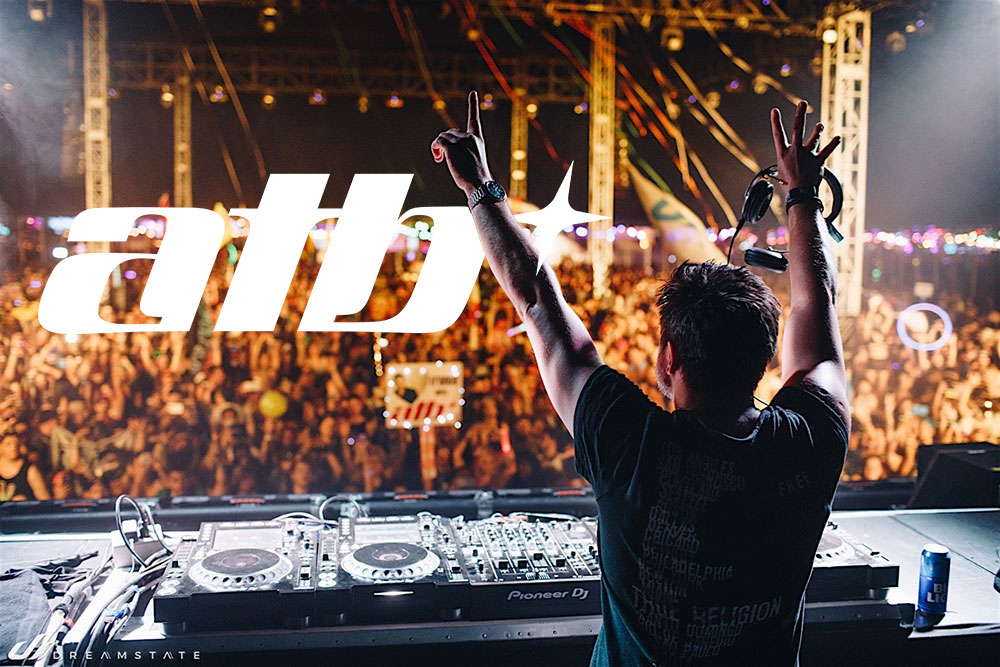
Producer, DJ and songwriter ATB—also known as Andre Tanneberger, is a 25-year veteran of the international music business. His sharp rise began when he founded his first project, Sequential One, in 1993. After a string of hits until 1998, Andre moved on to focus on his own music as ATB. When his debut single “9 PM (Till I Come)” shot to the very top of the UK charts and scored top 10 successes in many other countries around the globe. He followed with an impressive string of hits like “Ecstasy”, “Let U Go,” “What About Us,” “Move On,” “When It Ends It Starts Again,” and “Connected.” Gold and platinum awards in numerous territories underlined his status, mirrored by his constant presence in the prestigious DJ Mag Top 100 rankings for a decade and a half. ATB is one of just a handful of musicians to have emerged from the German club scene to become worldwide superstars–from Australia to Asia, Mexico to Poland, Russia and, above all, in the USA.
Given his impressive resume, we’re really glad to report that ATB is an enthusiastic Studio One user. We were able to have a Q&A session with him recently where he talked about his use of Studio One.
What PreSonus products have you used and which do you currently use?
Presonus Studio One is by far my favorite PreSonus product. I switched from Apple Logic Pro years ago. The other PreSonus tool I’m using is the Classic Faderport which is absolutely essential for me.
For what applications are you using Studio One Professional?
I’m Using Studio One Professional for the entire process of creating music. Starting with composing, sound design, going over to recording, editing, mixing and also mastering, I simply do everything in Studio One. I do have three workspaces so I can work from everywhere. Most of the times I’m in my main studio in Bochum, Germany to write and produce songs for my project ATB.
What led you to choose Studio One? Was it the company’s reputation, audio quality, ease of use, specific features, price, other factors?
Honestly, I never thought about the price. 🙂 I found this demo CD of Studio One in a friend’s office at Musicstore Germany back in 2013 and asked him “What the hell is this?” He told me some things about Studio One and that he really likes some features. I went back in my studio, checked the demo version and the next day I switched over from Logic Pro to Studio One. The reason was the speed of creating music. The personalized folders with my favorite plugins and favorite plugin settings, the audio editing, the speed and look of the GUI, and the audio quality which sounded awesome. So many features… like dragging and dropping ideas to my “faves” folder including MIDI and all plugins made me so much faster while creating music. And this is absolutely essential to me. Tools are there for pushing your creativity, not to outbreak it.
What Studio One features have proven particularly useful and why? 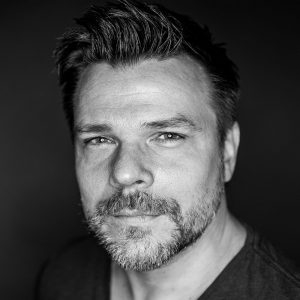
I love the scratchpad as it makes arranging super easy. This is something which helps me to be very fast in trying new arrangements and in cutting out or copying entire parts of a track. Also, many drag & drop functions are really helpful, like saving channel strips via drag & drop. The macros are great tools to speed up steps while editing.
How does Studio One compare to other DAWs you have used?
Studio One is faster than most other DAWs and also very intuitive. How often did I think, “How great it would be to simply do this and that to reach my goal like cutting my master, doing fades and just drag and drop it to my master folder in Studio One…” and it worked! Also, the integration of Melodyne is the ultimate weapon. I’m saving so much time and I can change things on the run without any bridge or without using it as a stand-alone app. It feels like I have an “all-in-one” solution.
Which Studio One feature or concept doesn’t get enough spotlight (or isn’t talked about enough) in your opinion?
What we mentioned while talking to other producers like the JUNKX team—Robin Schulz, etc.: they worked on Ableton Live and never thought that Studio One gives you the amount of speed you need to use your creativity as much as possible. It can be so fast and may other producers don’t know about it!! The integration of Melodyne and other apps via ARA is something which is really amazing and some producers might not know about it.
Also, most guys we’ve talked about Studio One over the last three years thought that it’s a DAW for rock music producers. Not a very modern and fast developing producer tool also for electronic music and pop etc.
Any useful tips/tricks or interesting stories based on your experience with Studio One that would be of interest to our user base?
Using the drag & drop function for MIDI files in case you’re having an idea or sound which doesn’t fit to the track you’re actually working at but which could really be amazing and inspiring for another one is a great tool. You’ll never forget any idea you once had, as you can create an acoustic note in a second.
Any final comments about PreSonus and Studio One?
I’m really looking forward to new developments in Studio One. I’m sure you guys will have the next surprise already in your pocket 😉
Follow ATB!
SonalSystem Dream Pop Guitars – new in the shop!
Immerse yourself in the rich sonic palette that is Dream Pop. Characterized by its slow-moving atmospheres and textures, SonalSystem’s Dream Pop Guitars will most certainly fill your track with good vibes.
Through the use of spacious guitars, evolving synth parts, and tasteful drum sequences SonalSystem’s Dream Pop Guitars captures the moodiness of this alt-rock subgenre.
Split across five titles, all of which are presented in song format (Intro, Verse, Chorus, Bridge, etc), SonalSystem’s Dream Pop Guitars is available in individual packs or as a complete bundle.
Click here to hear the demos and shop!
New Add-ons from Bingoshakerz
New at shop.presonus.com… Add-ons from Bingoshakerz! This is the first batch of add-ons we’ve received for the shop from this formidable production team… and from the sounds of things, we’re looking forward to more! These add-ons cover some diverse sonic territory—from contemporary, soulful vocals to late 1970s funk—and don’t overlook the Afro House Collection!
But enough talk. What you really need to do is hear these, am I right?
Click here to listen to the demos and shop!
These Add-Ons are compatible with Studio One Prime, Artist, and Professional (Versions 3.5.5 and higher.)

